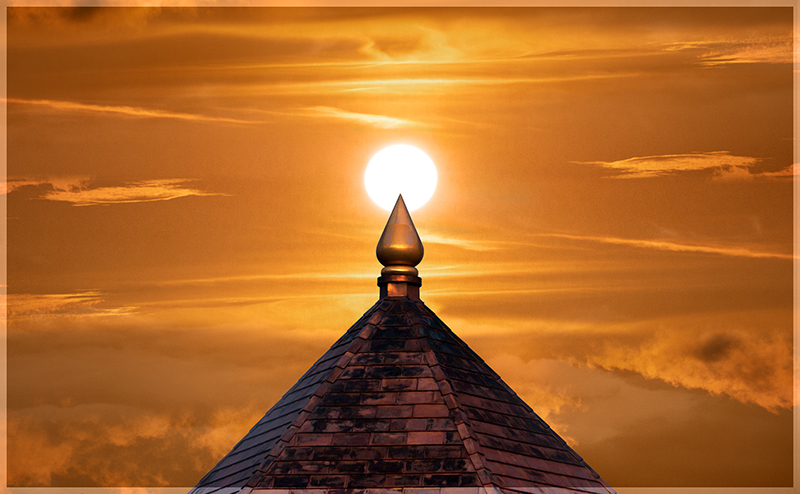The Self, Light of the Universe
Dharana by Gauri Maurer
“Be in the Temple” Satsang
Live Video Stream in the Siddha Yoga Universal Hall
Saturday, June 27, 2020
©Ⓟ2020 SYDA Foundation®. All rights reserved.
Please do not copy, record or distribute.

On the Siddha Yoga path, Gurumayi has taught us one of Baba Muktananda’s salient teachings: “God is looking for God. That supreme Truth is seeking the supreme Truth.”
To have a real and tangible experience of this teaching, you will now be meditating.
To support you to glide into meditation, I will walk you through a dharana, a centering technique for the mind and heart during meditation.
One of the most important things for an unperturbed meditation is to ensure that your physical posture is totally comfortable and steady, and that your nervous system is feeling at ease.
For this reason, you readjust your posture—whether you’re sitting on the floor or on a chair, on your bed, or on your sofa.
So, yes, wherever you are sitting, readjust your physical posture for profound and easeful meditation.
Another extremely important aspect of meditation is the spontaneous and natural breathing process. As you know, both the physical posture and the breathing process need to be adjusted and refocused again and again. They do need constant attention.
You’re sitting in a comfortable posture for meditation.
Your breathing is becoming more and more natural.
As you inhale deeply, the ribcage expands.
As you exhale long, your whole being experiences the refreshing energy.
Just as a gentle wind brings about movement in the leaves and branches of a tree, allow your body to sway gently in response to your robust and natural breathing.
When the breath is not moving optimally in every part of the body, you experience discomfort. So bring your attention to the place in your body where you feel discomfort.
Breathe into that region of the body.
Slowly and lightly close your eyelids.
Place three fingers on each of your eyelids. Feel how the eyelids softly cover the eyeballs.
Now, very gently, very delicately, massage the eyeballs.
First massage them clockwise, four times…
…and then counterclockwise, four times.
Remember to be gentle.
Don’t press too hard.
Now massage the eyes side to side—four times. Think of your fingers as being like velvet. Gentleness touching gentleness.
And finally, gently massage the eyes up and down four times.
Remember: the eyes are themselves houses of light.
It is the eyes that take light into our being.
Light passes through the front of the eye and travels all the way to the back of the eye, signaling our brain to make sense and meaning of what we see.
Relax the eye muscles.
Relax the eye muscles.
Relax the eye muscles.
You may rest your palms on your thighs with your thumb touching your forefinger. Feel the way this soft touch-point between thumb and forefinger brings energy to your entire body. This position of the fingers is called chin-mudra.
Or you may place your hands on top of each other, palms facing upward, in your lap. This is called dhyana-mudra.
Very gently, open your eyes.
And now, gently close your eyes.
Once again, sweetly open your eyes.
And sweetly close your eyes.
Tenderly open your eyes.
Tenderly close your eyes.
Lovingly open your eyes.
Lovingly close your eyes.
Slowly open your eyes.
Slowly close your eyes.
Now, I want you to bring in one more beautiful element—the breath, the prana, the most precious gift of life.
Combine the breath with the movement of the eyelids.
Breathe in deep as you open your eyes.
Breathe out long as you close your eyes.
Breathe in deep as you open your eyes.
Breathe out long as you close your eyes.
Breathe in deep as you open your eyes.
Breathe out long as you close your eyes.
Breathe in deep as you open your eyes.
Breathe out long as you close your eyes.
Breathe in deep as you open your eyes.
Breathe out long as you close your eyes.
Relish the soft touch of your eyelids against the spheres of your eyes.
The sages of the Upanishads have said:
sūryo yathā sarva-lokasya cakṣur
na lipyate cākṣuṣair bāhya-doṣaiḥ
ekas tathā sarva-bhūtāntarātmā
na lipyate loka-duḥkhena bāhyaḥ
The glorious sun god, who is the eye of the whole world, is not affected by the faults of the eyes, which are external to him. Likewise, the one inner Self of all beings is not affected by the suffering of the world, for it is independent of that.
Now, it’s time for meditation.
To go deeper into meditation, listen to the words of the dharana that I will walk you through.
I am the Sun.
I am the eye of the universe.
I am not affected by the faults of the eyes that only see outside.
I am the inner Self of all beings.
I am steady and composed in the face of outer suffering.
I am the one fire that enters and abides in all living beings.
I am the Self.
I am the Self of all.
I exist in all forms, and I exist outside all forms.
Meditate.



